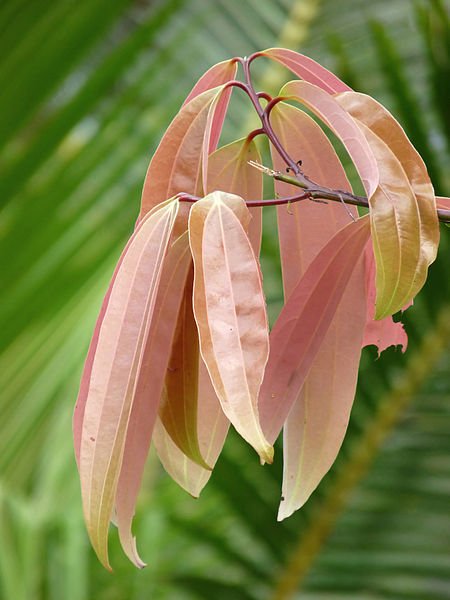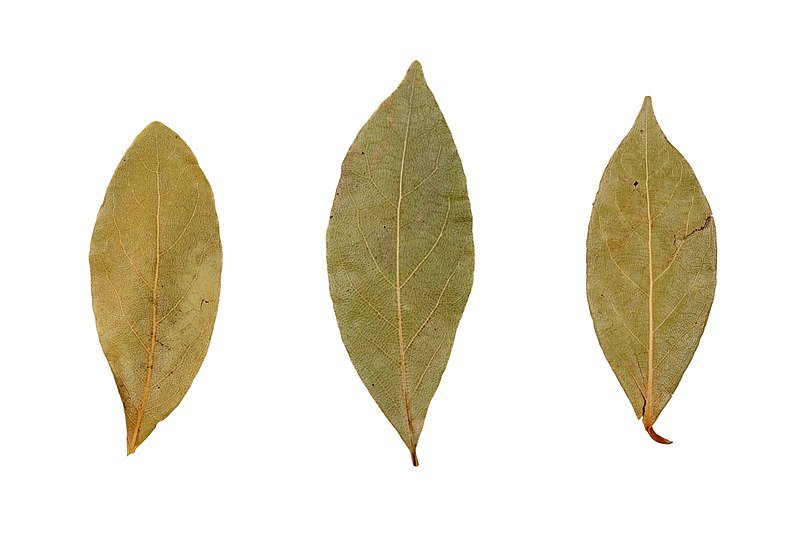Tejapatra ( Cinnamomum tamala ) Medicinal uses and pharmacology

Tejpatra- Cinnamomum tamala, Indian bay leaf', also known as ತಮಾಲ '(Tamaala) in Kannada(ಕನ್ನಡ), மரப்பட்டை இலை (Pattai Illai) in தமிழ்(Tamil), tezpat,tezapatta, Malabar leaf, Indian bark, Indian cassia, or malabathrum, is a tree in the family Lauraceae that is native to India, Bangladesh, Nepal, Bhutan, and China. It can grow up to 20 m (66 ft) tall. Its leaves have a clove-like aroma with a hint of peppery taste; they are used for culinary and medicinal purposes. It is thought to have been one of the major sources of the medicinal plant leaves known in classic and medieval times as malabathrum (or malobathrum).
Latin name- Cinnamomum tamala Nees.
Family- Lauraceae
Scientific classification
Kingdom: Plantae
Order: Laurales
Family: Lauraceae
Genus: Cinnamomum
Species: C. tamala
synonyms
- Cinnamomum albiflorum Nees
- Cinnamomum cassia D.Don nom. illeg.
- Cinnamomum lindleyi Lukman.
- Cinnamomum macrocarpum[1]
- Cinnamomum pauciflorum var. tazia (Buch.-Ham.) Meisn.
- Cinnamomum reinwardtii Nees
- Cinnamomum veitchii Lukman.
- Cinnamomum zwartzii Lukman.
- Laurus tamala Buch.-Ham
Names in different languages:
Hindi name- Tejpat, Dalchini, Silkanthi, Kikoa, Kirkiria, Taj kalam, Taj kalami, Talispatri
English name- Indian Bay leaf, Malabar leaf, Indian bark, Indian cassia
Assamese name- Dopatti
Arabic name- Sazij, Zarnab
Bengali name- Tejapat, Daruchini
Gujarathi name- Tamal patra, Tej
Kannada name- Patra, Dalchini
Marathi name- Tamalapatra, Daalchinitikki, Sambarapana
Malayalam name- Pacilla
Punjabi name- Tejpatra
Oriya name- Tejpatra
Tamil name- Talisapatri
Telugu name- Akupatri, Pattaakulu, Tallishapatri, Talisha
Tulu name- Ijin
Morphology of Cinnamomum tamala:
Tejpatta is a little tree developing to a tallness of 20-30 feet and is seen all over South India and Sri Lanka in the calm atmosphere. The bark of the tree is minimal fragile when cut and is earthy colored in shading with great scent. The leaves are thick, 4 to 7 inch long with profound vein like structure in the upper surface and have a solid smell when squashed. Blossoms are found in groups and have a solid scent. Organic products are round; purple hued and has a solitary seed inside. Blossoms are found in the period of January and the natural products show up in the long stretch of May-August. Chiefly three assortments of Tejpatra are accessible Indian, Sinhalese and Chinese.
Sanskrit Synonyms:
Chadana, Twak- The bark of the plant is used
Utkat- It is strong
Dala, Tamala Patra, Patra- The leaf is used
Gopana, Surabhi gandha- Has a good odor
Sukumaraka, Tapasajam, Vasana, Vastramamshuka, Palasha, Romasha, Chadanam
Classical categorization:
Bhavaprakasha- Karpooradi varga
Dhanvantari Nighantu- Shatapushpadi varga
Raja Nighantu- Pippalyadi varga
Kaiyyadeva Nighantu- Oushadhi varga
Nigantu Adarsha – Karpuradi varga
Madanapala Nigantu – Karpuradi varga
Priya Nigantu – Harthakyadi varga
Astanga Hridaya – Eladigana
Brihathg Nigantukara – Karpuradi varga
Shaligrama Nigantu – Harithakyadi varga
Habitat:
Mainly found in Himalayan region, south slopes of Himalayas, Khasi, Jaintia hills, west Bengal, Assam.
History:
As the name shows the fundamental part utilized is patra.The principle highlight of patra is that it is aromatic,having dull green shaded three veined.Leaves yield sweet-smelling oil which is having generally excellent restorative value.It is additionally called by the names like 'impactful leaf','Indian bay leaf','Cinnomomum'.They were notable to the Romans under the name Malobathrum and utilized both for perfumery and cooking.
Indian bay leaves were accessible during the medieval times and were utilized for honey bees preparing till the sixteenth century. In Moghul cooking style a lot of utilized is made of sweet and fragrant spices,hence this Cinnomomum,cloves and cardamom are considered as most significant flavors.
More vernacular names:
Burmese name – Thitchabo,Thitkyabo
Danish name – Indish Laurbaerblad
Espernato name – Hinda Cinnamomo
Finnish name – Lauries des Indes
German name – Indisches Lorburblatt
Hungarian name – Indiai baberlevel
Japanese name – Tamara-nikkei, Tezipatto
Medicinal properties of Indian Bay leaf:
Rasa (Taste) – Katu (Pungent), Tikta (Bitter), Madhura (Sweet)
Guna (Qualities) – Laghu (Light for digestion), Ruksha (Dry in nature), Teekshna (Strong)
Vipaka – Katu (Undergoes Pungent taste after digestion)
Veerya (Potency) – Ushna (Hot)
Karma (Actions) – Kaphavata shamaka (reduces vitiated kapha and vata dosha), Pittavardaka (Increases pitta dosha)
Part used- Leaf, Bark, Oil
Dosage-
Bark powder- 1 to 3 g
Leaf powder- 1 to 3 g
Oil- 2 to 5 drops
Chemical composition:
The oil from bark contains cinnamaldehyde (70–85%) as major constituent. Leaves from Nepal yield a volatile oil, containing mainly linalool 54.55%; cinnamaldehyde 1.45%, alpha-and beta-pinene, p- cymene and limonene. In essential oil from the leaves, mostly monoterpenoides were found. Linalool [50%] is a major compound.α-pinene, p- cymene and limonene range around 5 – 10% each. Phenylepropanides appear in little amount.

Uses of Tejpatra:
The bark is sometimes used for cooking, although it is regarded as inferior to true cinnamon or cassia. Methanolic extract of C. tamala leaves fed at 10 mg/kg to alloxan-induced diabetic rats for 15 days resulted in significant reduction in blood glucose level, blood glycosylated haemoglobin, LPO, serum AST, and ALT, and significant increase in the antioxidant enzymes such as CAT, GSH, and SOD. C. tamala could be used as an adjunct therapy in diabetes
The dried leaf and bark of Tejpatra is used as spice in many cuisines all over the world.
The powder of the bark of Cinnamomum tamala is used as tooth powder to treat dental caries, bad odor and gingivitis.
Powder of the bark of Tejpatra is mixed with honey in a dose of 3- 5 g to treat cough and asthma.
The oil extract of Cinnamomum tamala is used in a dose of 3 to 5 drops to treat dysmenorrhea and inflammation of the uterus.
The paste of the bark of the plant is applied as paste over the area affected with swelling and pain.
The oil of the herb is given in a dose of 3 to 6 drops to treat health complications arising out of tuberculosis.
The cold infusion of the bark of Cinnamomum tamala is given in a dose of 30-40 ml to improve the strength of cardiac muscles and stimulate the renal function.
Running nose – powder of cinnamon, patra, black pepper, cardamom should be inhaled.
Obesity – An ointment of patra, agaru, usheera and chandana removes foul smell of body in case of obesity(Vrinda madhava)
Compound pill is used in kaasa, flatulence and dyspepsia.
Oil distilled from the leaves is used in flavouring sweets and confectionaries.
Bark is used in treating
It is used as stimulant and also in Colic and
Given in kwatha or churna in suppression of lochia after child birth,with much benefit.
Leaf is diuretic,good for liver and speen.
Used in inflammation, sore eyes and stops salivation.
Uses as per Ayurveda:
Indicated in –
Arsha – haemorrhoids
Hrullasa – nausea
Aruchi – anorexia
Peenasa – rhinitis
Visha – Toxic conditions, poisoning
Bastiroga – diseases of urinarty tract
Kandu – itching, pruritis
Adverse effects: Increased use of Tejpatra can cause hyperacidity and oral ulcers.
Ayurvedic medicines containing Tejpatra:
Bangshil tablet, Arjunin capsule, Thyrocap capsules, Amirikalp gold, Lodhrasava, Kadalimadhusnuhee granules
Research articles related to Cinnamomum tamala:
Cinnamomum tamala (CT) Linn. (Lauraceae) is a component of Indian spices and is also used as antidiabetic agent. Its antioxidant potential was reported by other authors and recently our group has reported its immune-suppressive property. Here, CT leaves were extracted with methanol (CTT) and also with various organic solvents of increasing polarity such as hexane (CTH), ethyl acetate (CTEA), and methanol (CTE) in successive manner by continuous Soxhlet extractor. The active compounds of CTT and CTH were analyzed by GC-MS and most abundant compound (eugenol) was further analyzed by HPLC. These extracts were tested for their free radical (FR) scavenging potential for different FR species, hypoglycemic potential on alloxan-induced hyperglycemia, and anti-inflammatory property in carrageenan-induced paw edema and lipopolysaccharide (LPS)-induced nitric oxide (NO) production in rat peritoneal macrophage culture. Result showed that CTH was the most active fraction toward these parameters, which was parallel to its eugenol and total phenolic content concentration.
Anti- ulcer activity: Two active compounds that prevent serotonin-induced ulcerogenesis in rats were isolated from Chinese cinnamon (the stem bark of Cinnamomum cassia) and identified as 3-(2-hydroxyphenyl)-propanoic acid and its O-glucoside. The former compound, administered orally or parenterally to rats at a remarkably low dose (40 micrograms/kg body weight), also inhibited gastric ulcers induced by the other ulcerogens such as phenylbutazone, ethanol, and water immersion stress, although it failed to prevent indomethacin-induced ulcers. Pharmacological studies have shown that 3-(2-hydroxyphenyl)-propanoic acid hardly inhibited the secretion of gastric acid, but promoted the gastric blood flow. These results suggest that the antiulcerogenic effect of this compound is probably attributable to the potentiation of defensive factors through the improvement of the circulatory disorder and gastric cytoprotection.
Cinnamaldehyde, Cinnamic Acid, and Cinnamyl Alcohol, the Bioactives of Cinnamomum cassia Exhibit HDAC8 Inhibitory Activity: An In vitro and In silico
Anti- depressant activity
Gastroprotective activity of Cinnamomum tamala leaves on experimental gastric ulcers in rats

